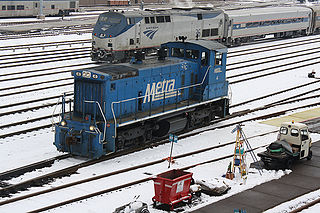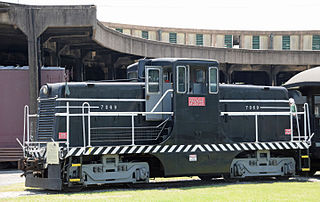
The American Locomotive Company was an American manufacturer that operated from 1901 to 1969, initially specializing in the production of locomotives but later diversifying and fabricating at various times diesel generators, automobiles, steel, tanks, munitions, oil-production equipment, as well as heat exchangers for nuclear power plants.

The Chicago, Burlington and Quincy Railroad was a railroad that operated in the Midwestern United States. Commonly referred to as the Burlington Route, the Burlington, or as the Q, it operated extensive trackage in the states of Colorado, Illinois, Iowa, Missouri, Nebraska, Wisconsin, Wyoming, and also in Texas through subsidiaries Colorado and Southern Railway, Fort Worth and Denver Railway, and Burlington-Rock Island Railroad. Its primary connections included Chicago, Minneapolis–Saint Paul, St. Louis, Kansas City, and Denver. Because of this extensive trackage in the midwest and mountain states, the railroad used the advertising slogans "Everywhere West", "Way of the Zephyrs", and "The Way West".

The Grand Trunk Western Railroad Company was an American subsidiary of the Grand Trunk Railway, later of the Canadian National Railway operating in Michigan, Illinois, Indiana, and Ohio. Since a corporate restructuring in 1971, the railroad has been under CN's subsidiary holding company, the Grand Trunk Corporation. Grand Trunk Western's routes are part of CN's Michigan Division. Its primary mainline between Chicago and Port Huron, Michigan serves as a connection between railroad interchanges in Chicago and rail lines in eastern Canada and the Northeastern United States. The railroad's extensive trackage in Detroit and across southern Michigan has made it an essential link for the automotive industry as a hauler of parts and automobiles from manufacturing plants.

The Elgin, Joliet and Eastern Railway was a Class II railroad, making a roughly circular path between Waukegan, Illinois and Gary, Indiana. The railroad served as a link between Class I railroads traveling to and from Chicago, although it operated almost entirely within the city's suburbs, only entering Chicago where it served the U.S. Steel South Works on the shores of Lake Michigan. Nicknames for the railroad included "The J" and "The Chicago Outer Belt Line". At the end of 1970, the EJ&E operated 164 miles of track and carried 848 million ton-miles of revenue freight in that year alone.

The EMD SW1500 is a 1,500 hp (1,119 kW) diesel-electric switcher locomotive built by General Motors' Electro-Motive Division from 1966 to 1974. The SW1500 replaced the SW1200 in the EMD product line. Many railroads regularly used SW1500s for road freight service.

Electro-Motive Diesel is a brand of diesel-electric locomotives, locomotive products and diesel engines for the rail industry. Formerly a division of General Motors, EMD has been owned by Progress Rail since 2010. Electro-Motive Diesel traces its roots to the Electro-Motive Engineering Corporation, founded in 1922 and purchased by General Motors in 1930. After purchase by GM, the company was known as GM's Electro-Motive Division. In 2005, GM sold EMD to Greenbriar Equity Group and Berkshire Partners, and in 2010, EMD was sold to Progress Rail. Upon the 2005 sale, the company was renamed to Electro-Motive Diesel.

An EMD SW1200 is a four-axle diesel switcher locomotive built by General Motors Electro-Motive Division between January 1954 and May 1966. Power is provided by an EMD 567C 12-cylinder engine, which generates 1,200 horsepower (890 kW). Additional SW1200 production was completed by General Motors Diesel in Ontario, Canada, between September 1955 and June 1964.

The EMD SD9 is a model of diesel locomotive built by General Motors Electro-Motive Division between January 1954 and June 1959. An EMD 567C 16-cylinder engine generated 1,750 horsepower (1.30 MW). Externally similar to its predecessor, the SD7, the SD9 was built with the improved and much more maintainable 567C engine.
The GE U23B was a 2,250 horsepower diesel-electric locomotive built by GE Transportation from 1968 to 1977. It was one of the most successful models of the Universal Series, with 481 units built, including 16 exported to Peru. The U23B was replaced by the B23-7.

Progressive Rail Inc. is a shortline railroad and owner of several other shortlines. PGR is directly operating several separate branches in Minnesota including the Airlake Terminal Railway. Progressive Rail also acquired the Wisconsin Northern Division in Chippewa Falls, Wisconsin and operates as a separately-named division. They also own the Chicago Junction Railroad, Clackamas Valley Railway, the Iowa Traction Railway and Iowa Southern Railway in Iowa, the Crab Orchard and Egyptian Railroad in Illinois, the St. Paul & Pacific Northwest Railroad, and the Wisconsin Northern Railroad.

The GE 44-ton switcher is a four-axle diesel-electric locomotive built by General Electric between 1940 and 1956. It was designed for industrial and light switching duties, often replacing steam locomotives that had previously been assigned these chores.

The ALCO RS-1 was a 4-axle diesel-electric locomotive built by Alco-GE between 1941 and 1953 and the American Locomotive Company from 1953 to 1960. ALCO subsidiary Montreal Locomotive Works built an additional three RS-1s in 1954. This model has the distinction of having the longest production run of any diesel locomotive for the North American market. The RS-1 was in production for 19 years from the first unit Rock Island #748 in March 1941 to the last unit National of Mexico #5663 in March 1960.

The Strasburg Rail Road is a heritage railroad and the oldest continuously operating standard-gauge railroad in the western hemisphere, as well as the oldest public utility in the Commonwealth of Pennsylvania. Chartered in 1832, the Strasburg Rail Road Company is today a heritage railroad offering excursion trains hauled by steam locomotives on 4.02 mi (6.47 km) of track in Pennsylvania Dutch Country, as well as providing contract railroad mechanical services, and freight service to area shippers. The railroad's headquarters are outside Strasburg, Pennsylvania.

The McCloud Railway was a class III railroad operated around Mount Shasta, California. It began operations on July 1, 1992, when it took over operations from the McCloud River Railroad. The MCR was incorporated on April 21, 1992.

The Baldwin VO-1000 is a diesel-electric switcher locomotive built by the Baldwin Locomotive Works between January 1939 and December 1946. These units were powered by a naturally aspirated eight-cylinder diesel engine rated at 1,000 horsepower (746 kW), and rode on a pair of two-axle trucks in a B-B wheel arrangement. These were either the AAR Type-A switcher trucks, or the Batz truck originally developed by the Atchison, Topeka and Santa Fe Railway as a leading truck for steam locomotives. 548 examples of this model were built for American railroads, including examples for the Army and Navy.
The RS1325 is a North American locomotive model built by Electro-Motive Division, having characteristics of both a switcher locomotive and a road switcher locomotive. Only two units were built.
The Louisiana Eastern Railroad (LE) was a proposed railroad that was to serve as an alternate line bypassing the congested rail lines in New Orleans, Louisiana. The railroad was envisioned by Paulsen Spence in the late 1940s and early 1950s, and while most US railroads had or began to replace their steam locomotives with diesel locomotives, the LE was to operate exclusively with steam locomotives which Spence had collected over time. He died in 1961, and the railroad had never fully materialized.
The Thermal Belt Railway is a Class III shortline railroad that operates for freight service on an irregular schedule on a former CSX line from Bostic to Forest City and on a former Norfolk Southern line from Forest City to Alexander Mills, North Carolina. Total mileage is 8.5 miles (13.7 km). Connections are made with CSX at Bostic. Rail is 85 pounds.
Beginning in 1917, steam locomotives were gradually retired and replaced by diesel and electric locomotives. The timeframe of this process varied by country.

St. Louis, Iron Mountain and Southern Railway #5 is a 2-4-2 "Columbian" type steam locomotive. It was originally built by H.K. Porter, Inc. in 1946 as a saddle tank engine for the Central Illinois Public Service Company. In 1963, the locomotive was donated to the Mid-Continent Railway Museum in North Freedom, Wisconsin as a static display piece. In 1971, #5 was sold to the Crab Orchard and Egyptian Railway to be restored to operating condition, and #5 began pulling passenger excursions on the Crab Orchard and Egyptian's track line, as well as occasional freight runs. During this career, the locomotive was converted to a tender locomotive, and the saddle tank over the boiler was presumably scrapped. In 1985, #5 was sold again to the St. Louis, Iron Mountain and Southern Railway, who one year later began using the locomotive to run tourist trips in Missouri. This career lasted until 1999. Presently, the #5 is out of service, waiting for an overhaul to be completed.















